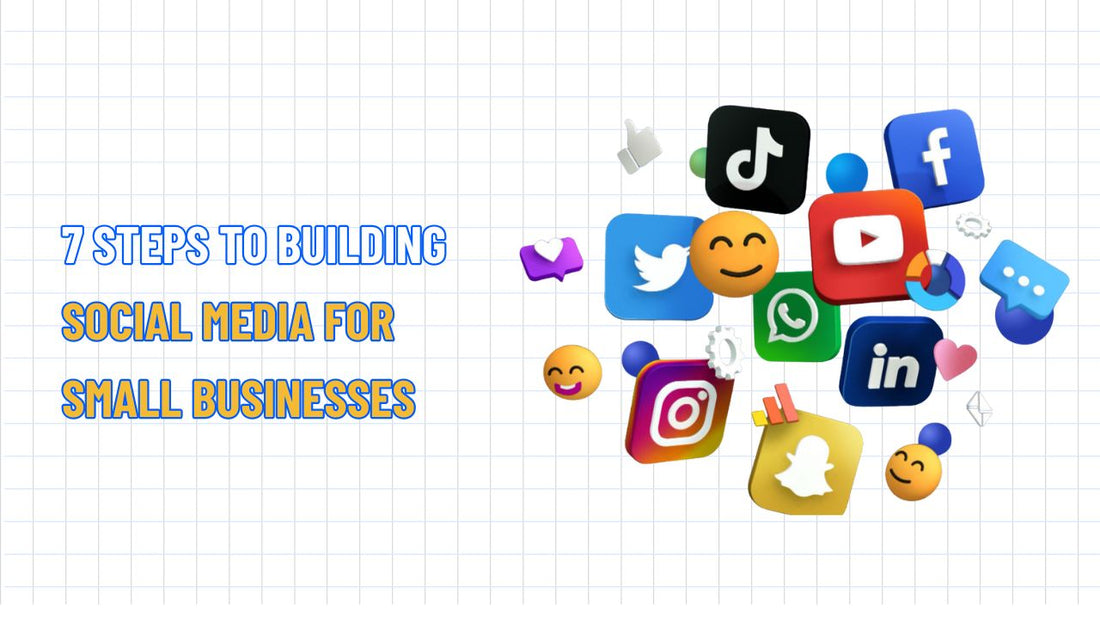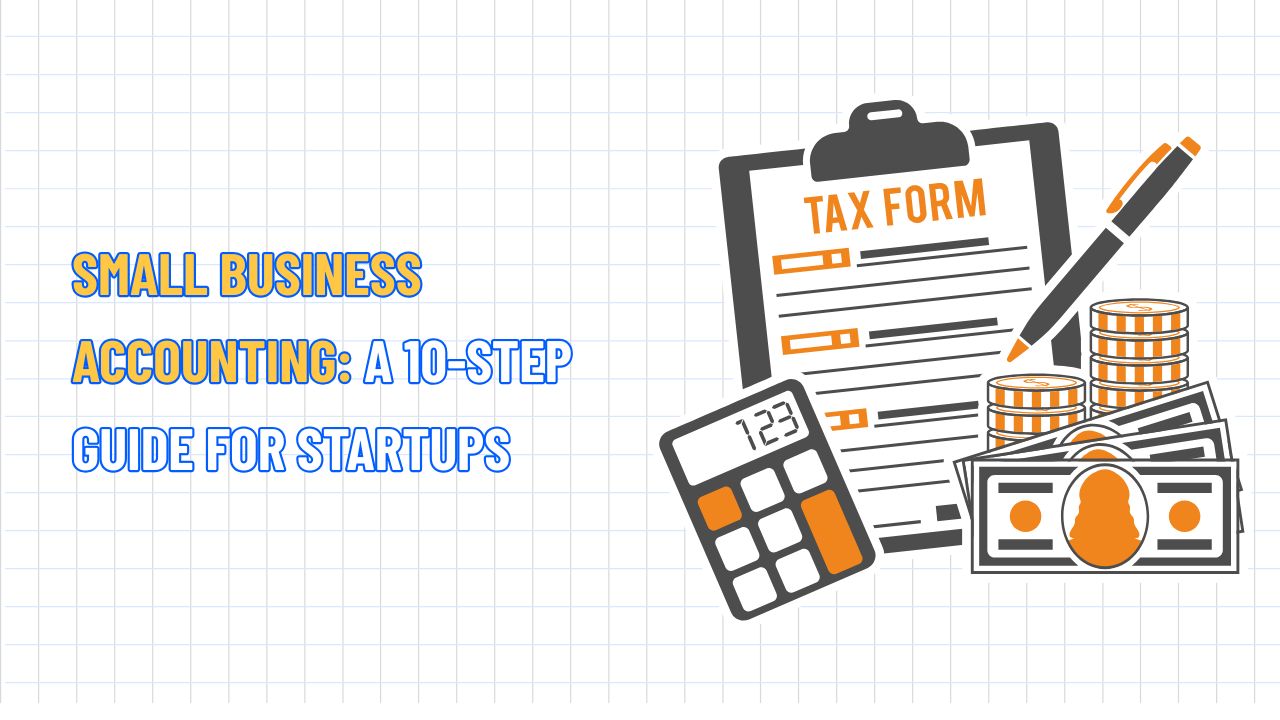7 Steps to Building Social Media for Small Businesses
Table of Contents Hide
Social media for small businesses has become an indispensable tool in the digital age. With billions of active users daily on Facebook, Instagram, LinkedIn, and TikTok, social media is the channel that lets you connect directly with customers and boost brand recognition. In this article, NextSky dives into practical strategies to help you stand out in a competitive market.
How to use social media for small business success
Building an effective social media strategy for a small business requires a thoughtful approach. Below are practical steps to create a strong presence, drive growth, and boost engagement.
Step 1: Set clear goals and KPIs
You need clear goals from the start for a social media strategy to deliver high results. These goals are especially essential for small businesses, they help focus resources and aim for measurable outcomes.

- Brand awareness: Increase followers, likes, and shares to expand reach and heighten brand recognition.
- Lead generation: Drive traffic to your website or collect email sign-ups to build a customer database.
- Customer engagement: Foster loyalty and connection through personalized responses and interactive content.
- Sales growth: Promote products or services to convert followers into paying customers and boost revenue.
It's crucial to tie these goals to trackable KPIs like engagement, click-through, or conversion rates. For example, a B2C business might track Instagram Story views, while a B2B one could measure lead conversions on LinkedIn.
Practical tip: Set goals and KPIs upfront so you can track and tweak your strategy as needed, ensuring sustainable results.
Read more: What is A Small Business? A Comprehensive Guide to Definition
Step 2: Identify your target audience
Understanding your audience is key to creating relevant, high-impact content. To do this, dive deep into factors like demographics, interests, and behaviors.
- Demographic research: Pinpoint elements like age, gender, location, and other traits. For instance, if targeting Gen Z, TikTok and Instagram are ideal platforms, as about 55% of TikTok users are women and over 30% of Instagram users are aged 18-24.
-
Build buyer personas: Create detailed profiles of your ideal customers to shape tailored content strategies by asking:
- What challenges does my audience face?
- What content types do they engage with? (e.g., videos, tutorials, memes)
- Which platforms do they spend the most time on?
Helpful tip: Once you know your audience, crafting engaging content and reaching the right people gets easier. Continuously monitor and update their habits to keep your strategy effective.
Read more: Small Business SEO Guide to Help You Grow Your Presence
Step 3: Choose the right platforms
Each social platform has unique strengths, and selecting ones that align with your audience and business goals is vital for optimizing your marketing strategy. Here's a rundown of platforms to consider by industry:
- Facebook: With over 3 billion monthly users, it's ideal for B2B and B2C businesses to reach a broad audience, handle customer service, and run effective ads.
- Instagram: A visual powerhouse, perfect for retail, fashion, or food brands to showcase products via Stories and Reels for maximum engagement.
- LinkedIn: With 80% of B2B leads coming from the platform, it's excellent for building industry credibility, connecting with partners and prospects, and growing professional networks.
- TikTok: Ideal for reaching younger audiences with creative short videos—it's a top platform for boosting visibility for new accounts.
- X: Perfect for quick updates and direct customer interactions, building strong ties with journalists and influencers.
- Pinterest: With 42% of U.S. women on the platform, it's a match for aesthetics-driven industries like fashion, travel, and interior design.

Step 4: Develop a content strategy
Content is the bridge that delivers viewers information, entertainment, and inspiration. To create compelling, high-performing posts, try these tips:
- Show products in action: Share demo videos, how-tos, or behind-the-scenes clips to highlight your offerings. For example, a bakery could post Reels of cake-decorating processes to showcase craftsmanship and quality.
- Encourage user-generated content (UGC): Invite customers to share photos, videos, or reviews of your products. Reposting UGC builds trust and saves time when creating fresh content.
- Balance value and promotion: Follow the 80/20 rule—80% of content should educate or entertain, with 20% promoting products or services.
- Use edutainment: Blend education and entertainment to captivate viewers. A tech startup might share software tips via fun animated videos, making learning enjoyable.
Practical tip: Every content should have a clear goal, deliver real value, and prompt immediate action from users.
Read more: Small Business Marketing Guide with Effective Tips
Step 5: Engage positively with your audience
Engagement is crucial for building lasting customer relationships on social media. Respond promptly to comments, messages, and reviews to foster trust and loyalty. Here are ways to optimize interactions:
- Host Q&A sessions or live streams: Give customers a chance to ask questions and get real-time answers, strengthening trust and bonds.
- Run polls or contests: Spark participation with votes or giveaways to boost engagement and excitement in your community.
- Share UGC: Feature customer-created content to show appreciation and encourage more contributions.
Real data: According to the Sprout Social Index 2025, personalized customer service is consumers' top priority. Genuine, timely interactions retain customers and set your brand apart.

Step 6: Invest in social media advertising
Social ads can be a powerful tool for small businesses to expand reach and drive results. Here's how to optimize your campaigns:
- Targeted ads: Use platform tools to reach the right audience based on demographics, interests, or behaviors, boosting conversions and saving money.
- Retargeting: Show ads to those who've interacted with your site or content to nudge them toward action.
- Creative content: Pair eye-catching visuals with concise, clear messaging to grab attention and spark engagement.
Real example: A Shopify store could run Instagram ads highlighting a new collection, targeting users who've viewed similar items to increase sales chances.
Step 7: Use tools to streamline your workflow
Social media management tools save time and optimize your efforts. Consider these to elevate your strategy:
- Sprout Social: Schedule posts, analyze data, and track customer interactions to refine your approach with real insights.
- Hootsuite: Manage multiple platforms from one dashboard, monitor conversations, and engage across channels.
- Canva: Easily create stunning visuals and graphics without pro skills, producing eye-catching content.
Advice: Schedule posts ahead for consistency, but avoid automating interactions. Personalized responses are key to building trust and long-term connections.

Step 8: Monitor and optimize performance
Use analytics tools like Sprout Social, Hootsuite, or Buffer to track social performance. Key metrics include:
- Engagement: Likes, comments, shares, and saves to gauge user interest and connection.
- Reach and impressions: Number of people exposed to and viewing your content, showing strategy reach.
- Traffic and conversions: Website visits and sales from social, revealing real impact.
- Customer sentiment: Feedback and perceptions of your brand, helping understand audience love and trust.
Benefits of social media marketing for small businesses
Social media marketing is a game-changer, beyond surface metrics like likes and shares. Here are the core benefits and top values for standout success:
- Boost brand awareness: A strong social presence makes your brand discoverable. For example, 78% of consumers find products via Facebook, and Instagram's visuals drive discovery among younger audiences.
- Increase website traffic: Strategic calls-to-action (CTAs) in posts can funnel visitors to your site, complementing SEO and improving lead quality.
- Attract new customers and grow sales: Targeted social ads convert followers to buyers by showcasing products and offers.
- Improve customer service: Social platforms enable instant query responses, enhancing satisfaction and loyalty.
- Valuable market insights: Social provides a goldmine of customer behavior, preferences, and trends for data-driven decisions.
Set SMART goals for social media success
Start with clear, measurable goals to maximize social media marketing benefits for small businesses. Here are SMART goal examples you shouldn't miss:
- Brand awareness: Grow Instagram followers by 20% in 6 months with engaging posts 3 times weekly.
- Lead generation: Generate 50 qualified marketing leads monthly via LinkedIn ads targeting 25–45-year-old professionals.
- Customer engagement: Hit 10% engagement rate on Facebook posts by replying to all comments within 24 hours next quarter.
- Website traffic: Increase monthly site visits by 1,000 from social by adding CTAs to 80% of posts over 3 months.
With specific goals, track KPIs like engagement rates, click-throughs, and conversions to measure success.
Social media tips for small businesses
Here are 15 social media marketing tips for small businesses to level up your strategy:
- Stay authentic: Share your brand story and core values to forge emotional connections.
- Showcase products in real life: Use videos or reels to demonstrate how products solve customer problems.
- Invest in quality visuals: Use pro photos or tools like Canva for eye-catching graphics.
- Post consistently: Aim for 1–2 posts/day on Instagram, 5–7/week on Facebook, and 2–3 tweets/day on X.
- Leverage hashtags: Use relevant ones like #SmallBusiness or #LocalShopping to boost visibility.
- Partner with influencers: Collaborate with micro-influencers for genuine brand promotion.
- Run mini-games and giveaways: Boost interaction with contests requiring likes, shares, or tags.
- Track performance: Use platform analytics to see what content resonates most.
- Engage proactively: Reply to comments and messages within 24 hours to build trust.
- Vary formats: Experiment with Stories, Reels, carousels, and live streams to find what works.
- Be transparent and relatable: Share behind-the-scenes content to humanize your brand.
- Use smart AI: Leverage AI for analysis and scheduling, but keep customer chats natural.
- Encourage employee advocacy: Motivate staff to share company news on personal accounts for broader reach.
- Stay trend-savvy: Keep up with industry trends to ensure fresh, relevant content.
- Prepare for crises: Develop clear response plans to handle communication risks effectively.
Social media for small businesses is a game-changer, offering unprecedented opportunities to connect with customers, drive sales, and build lasting brands. NextSky hope these insights help you pick the right platforms to compete with bigger players in the digital space.










